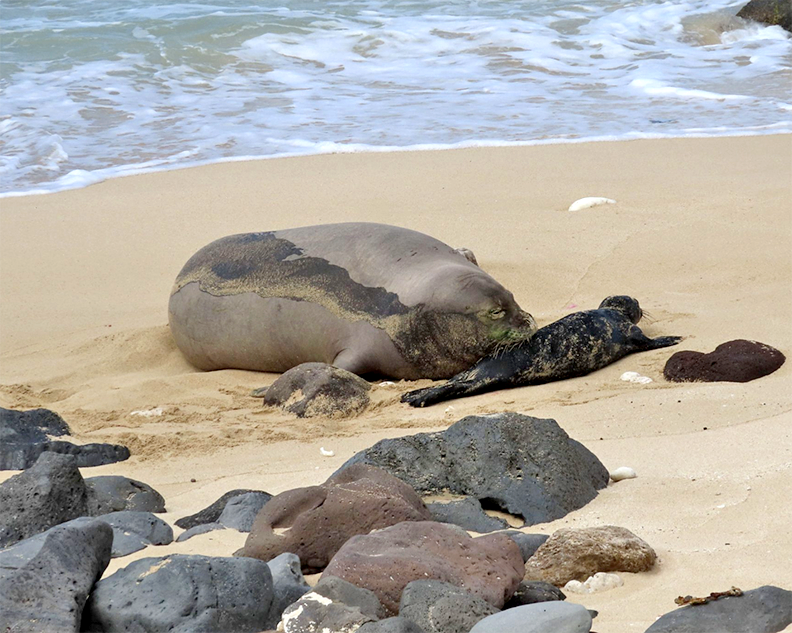By Léo Azambuja

Hawaiian language instructor Keao NeSmith addresses the crowd at the opening of the Kaua‘i Conservation Expo.
As a child, man-driven extinction was a tough concept for me to grasp. I was heartbroken upon learning the fate of the dodo, a flightless bird from Mauritius Island in the Indian Ocean. Three-foot tall and weighing nearly 50 pounds, the dodo was first documented by Dutch sailors in 1598. It would become extinct only 64 years later, due to hunting, habitat destruction and invasive species.
The same reasons led to the extinction of the Tasmanian tiger, the largest known carnivorous marsupial of modern times. In 1901, conservationists rallied to protect it, but the Tasmanian government only introduced official protection on July 10, 1936, six years after the last wild Tasmanian tiger was shot dead, and 59 days before the last specimen in captivity died of neglect in a Tasmanian zoo. It was more than a little too late to save it.
We have come a long way since the demise of the dodo and the Tasmanian tiger. We have brought back several species from the brink of extinction, including the nēnē goose, Hawaiian monk seals, Newell’s shearwaters, bald eagles, peregrine falcons, the American bison, gray wolves, green sea turtles, humpback and gray whales, giant Galapagos tortoises, black-footed ferrets, Virginia northern flying squirrels, Indian rhinos, Siberian tigers, manatees and the list goes on.
Much of this was possible due to a combination of efforts from government agencies, nonprofit organizations, volunteers and activists, especially after President Richard Nixon signed the Endangered Species Act of 1973, replacing the flawed Endangered Species Conservation Act of 1969.

Dancers from kumu hula Sabra Kauka’s hula halau are seen here performing at the opening of the Kaua‘i Conservation Expo.
From Sept. 1 to 10, the International Union for Conservation of Nature held its World Conservation Congress in Honolulu. For Hawai‘i, it was a milestone event; it was the first time since IUCN’s creation in 1948 that the event — held every four years — was in United States soil. Some 8,500 people attended the event.
At the closing of the WCC, members of the IUCN (made of 161 countries, 217 state and government agencies, 1,066 nongovernmental organizations and 16,151 experts from six commissions) adopted the “Hawai‘i Commitments,” a document setting the opportunities to meet key conservation challenges identified at the event.
Held during the WCC in Honolulu, the Kaua‘i Conservation Expo at the National Tropical Botanical Garden in Lawa‘i highlighted several nonprofit organizations and federal, state and local government agencies working to preserve Hawai‘i’s environment and unique species.
Although we are moving on a positive direction, the future is still grim for thousands of species worldwide. The IUCN’s Red List of Threatened Species contains almost 83,000 species ranging from “Least Concern” to “Critically Endangered,” and from the dreaded “Extinct in the Wild” to simply “Extinct.”
According to the World Wildlife Fund, “the rapid loss of species we are seeing today is estimated by experts to be between 1,000 and 10,000 times higher than the natural extinction rate.” This “natural extinction rate” is what experts call the rate of species extinction that would naturally occur if humans were not around.
Calculating the rate of species extinction is a complicated matter, because there is no definitive number on how many species are on Earth.
Scientists say there are at least 2 million different species on the planet (between 1.4 and 1.8 million have already been scientifically identified), with some arguing there could be as many as 100 million. The discrepancy is because “scientists have a better understanding of how many stars there are in the galaxy than how many species there are on Earth,” according to the World Resources Institute.
With that said, experts calculate between 0.01 percent and 0.1 percent of all species become extinct annually. If we consider there are 2 million species on Earth, 200 to 2,000 species become extinct annually. If there are 100 million species here, between 10,000 and 100,000 vanish annually.
Since humans alone have grossly accelerated the “natural extinction rate,” the key outcome of the WCC in Honolulu; “connecting people to nature,” is of the utmost importance.
“#NatureForAll is IUCN’s new global movement founded on a simple idea: the more people experience, connect with, and share their love for nature, the more support there will be for its conservation in the future,” IUCN posted on its website following the WCC.
Had the Tasmanian tiger and the dodo been able to hang around a while longer, they might’ve gotten a shot at survival due to an increasing global conservation consciousness.
Unbelievably enough, a slim hope for the Tasmanian tiger still lingers, thanks to a few unconfirmed sightings in the last couple decades. But the dodo, in all its cute clumsiness, size and weight, is gone for sure.
Never forget the dodo. Stand up for conservation.
Discover more from ForKauaiOnline
Subscribe to get the latest posts sent to your email.




Leave a Reply